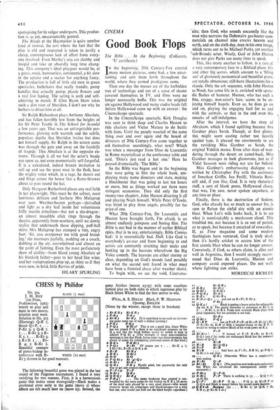CHESS by Philidor
No. 304 J. M. RICE
(rat Prize, Problemisten, 1963) WHITE to play and mate in two moves; solution next week. Solution to No. 303 (Hartong): Q-R 7, threat Qx P. i. . . P-Kt 3; 2 Q-R 7.
z B-Kt 3; 2 R- K S. z . R-Kt 3; 2 R x B. .. Kt- R 4; 2 R-Kt 6. Beautiful example of pawn-bishop in- terference with R- Kt 3 thrown in for
BLACK (5 men)
WHITE (II men) good measure.
The following beautiful game was played in the last round of the Paignton tournament. I found it- very satisfying for two reasons. First, it is a harmonious game that makes sense strategically—Black makes a positional error early in the game (move 5) whose effects are felt much later on (move 23). Second, the game finishes (moves 23-35) with some excellent tactical play on both sides in which ingenious play by Black forces White to find the best moves to win.
White, A. S. HOLLIS Black, P. W. HEMPSON Opening, ENGLISH (Notes by the winner, except those in brackets) z Kt-K B3 Kt-K 11. 3
a P-B 4 PL-13 4
3 Kt-B 3 Kt-B 3 (It is surprising to see such an interest-
ing_pme come out of such a dismal opening.) 4 P- K3
3 P-Q 4 SP 13? This is not a good idea. Since White has not played P-K 4 there is no significant pressure on his Q 4 and also the black bishop would be useful to help to achieve P-9 Kt 4. [The strength of these non-committal openngs is just that Black, being under less direct pressure, has plenty of scope for committing positional errors of this kind]
6 B-K a P-K Kt 3
7 P -Q B x Kt Of course not Kt-K 4 ?; It Kt x Kt, B x B; Q-R 4 ch
8 BxB Kt-K4 9 13-K B-Kt a zo 0-0 0-0
rr P-Q Kt 3 Kt (4)-Q a
22 R-ICt r Kt-K
r3 Q-B 2 P-K 4 Hardly good, but apparently the only
way to get any counter-chances. 14 PxP e.p. PxP 13 B-KS a Q-K • Q R-Q z Kt-K
17 P-B 4 1 . . . The pawn weakness thus created is out-
weighed by the extra scope for the bishop on K B 3. [A move of the kind only played by a very good player—who would correctly weigh the advantages and disadvantages—or a very bad one, who would just kick out the black knight regardless.] Kt-Q B 3
• 13-11 3 Kt-Kt 5 zg 0Q-Kt x Q R-Q 20 P-2 R3 Kt-R3 22 R- 2 Q Kt-B a 22 R at 2)-Q 1 and not 22 B x P?, R-Kt r. 22 i42.3 23 Q-K Black is paying a heavy price for relinquish- mg his K B. The AUCCI1 threatens to penetrate to Kt 7, or if . . . R-Kt a, to B 6. From now onwards Black plays with ty great ingenuity, but his position is too bad.
Kt-13 3
24 Q-Kt 7 P-Q 4 25 QxRP not2sPxP,PxP;26KtxP,Kt(a)xKt; 27 B x Kt ch, K-R 1 with a counter-threat to the K P. It would be wrong to relieve Black of his weak pawn on K 3.
PxP
26 Kt-Kt. . . If instead 26 P x P, R xR; 27 xR, RA) and if the rooks are exchanged Black has the awkward threat of Q-Q 7.
26 RxR
27 R x R Kg (1)-Q 4
28 PxP BxB
29 RxB. And here 29 P x Kt, B-B 8!; 3o P-Q 6, Q-Kt 2 is not clear. Q-B 3 Otherwise White has a comfortably won ending. 3. PxKt Q x R • KtXXt Q-Q 7 [The position now looks quite menacing, but White has calculated the consequences calmly and accurately.)
32 P-K 3 QxP ch
33 K-Kt 2 P xP There is. nothing in 33 . . . QTQ 7 ch; K-R3. 34 xP QxRP If34 . 33 QkB p or 6 and Black is mated before'his pawn maws., 33 Q- 6 ch Resigns [35 . . . K- t . 2; 36 Q-K 7 cb, R-B 2; 37 Kt-K 6 ch.]






































 Previous page
Previous page